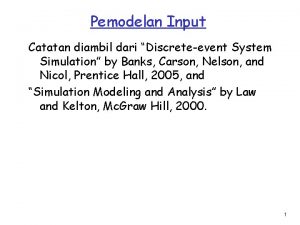CSE 331 Software Design Implementation Hal Perkins Winter
























![Example 1 int find(int[] a, int value) { for (int i=0; i<a. length; i++) Example 1 int find(int[] a, int value) { for (int i=0; i<a. length; i++)](https://slidetodoc.com/presentation_image_h2/8ec1899c28e7d5401b9a9d18e78116bf/image-25.jpg)
![Example 2 int find(int[] a, int value) { for (int i=0; i<a. length; i++) Example 2 int find(int[] a, int value) { for (int i=0; i<a. length; i++)](https://slidetodoc.com/presentation_image_h2/8ec1899c28e7d5401b9a9d18e78116bf/image-26.jpg)




- Slides: 30

CSE 331 Software Design & Implementation Hal Perkins Winter 2013 Specifications (Slides by Mike Ernst) 1

2 Goals of Software System Building • Building the right system – Does the program meet the user’s needs? – Determining this is usually called validation • Building the system right – Does the program meet the specification? – Determining this is usually called verification • CSE 331: the second goal is the focus – creating a correctly functioning artifact – It’s surprisingly hard to specify, design, implement, test, and debug even simple programs 2

Where we are • We’ve started to see how to reason about code • We’ll build on those skills in many places: – Specification: What are we supposed to build? – Design: How do we decompose the job into manageable pieces? Which designs are “better”? – Implementation: Building code that meets the specification (and we know it because we can prove it!) – Testing: OK, we know it’s right, but is it? – Debugging: If it’s not, how do we systematically find the problems and fix them? – Maintain: How does the artifact adapt over time? – Documentation: What do we need to know to do these things? How/where do we write that down? (Comments, Java. Doc, UML(? ), …) 3

The challenge of scaling software • Small programs are simple and malleable – easy to write – easy to change • Big programs are (often) complex and inflexible – hard to write – hard to change • Why does this happen? – Because interactions become unmanageable • How do we keep things simple and malleable? 4

A discipline of modularity • Two ways to view a program: – The implementer's view (how to build it) – The client's view (how to use it) • It helps to apply these views to program parts: – While implementing one part, consider yourself a client of any other parts it depends on – Try not to look at those other parts through an implementer's eyes – This helps dampen interactions between parts • Formalized through the idea of a specification 5

A specification is a contract • A set of requirements agreed to by the user and the manufacturer of the product – Describes their expectations of each other • Facilitates simplicity by two-way isolation – Isolate client from implementation details – Isolate implementer from how the part is used – Discourages implicit, unwritten expectations • Facilitates change – Reduces the “Medusa” effect: the specification, rather than the code, gets “turned to stone” by client dependencies 6

Isn’t the interface sufficient? The interface is to defines the boundary between the implementers and users: public interface List<E> { public E get(int); public void set(int, E); public void add(int, E); … public static boolean sub(List<T>, List<T>); } Interface provides the syntax But nothing about the behavior and effects 7

Why not just read code? boolean sub(List<? > src, List<? > part) { int part_index = 0; for (Object o : src) { if (o. equals(part. get(part_index))) { part_index++; if (part_index == part. size()) { return true; } } else { part_index = 0; } } return false; } Why are you better off with a specification? 8

Code is complicated • Code gives more detail than needed by client • Understanding or even reading every line of code is an excessive burden – Suppose you had to read source code of Java libraries in order to use them – Same applies to developers of different parts of the libraries • Client cares only about what the code does, not how it does it 9

Code is ambiguous • Code seems unambiguous and concrete – But which details of code's behavior are essential, and which are incidental? • Code invariably gets rewritten – Client needs to know what they can rely on • What properties will be maintained over time? • What properties might be changed by future optimization, improved algorithms, or just bug fixes? – Implementer needs to know what features the client depends on, and which can be changed 10

Comments are essential • Most comments convey only an informal, general idea of what the code does: // This method checks if “part” appears as a // sub-sequence in “src” boolean sub(List<? > src, List<? > part) {. . . } • Problem: ambiguity remains – e. g. what if src and part are both empty lists? 11

From vague comments to specifications • Properties of a specification: – The client agrees to rely on information in the description in their use of the part – The implementer of the part promises to support everything in the description • otherwise is perfectly at liberty • Sadly, much code lacks a specification – Clients often work out what a method/class does in ambiguous cases by simply running it, then depending on the results – This leads to bugs and to programs with unclear dependencies, reducing simplicity and flexibility 12

Recall the sublist example T boolean sub(List<T> src, List<T> part) { int part_index = 0; for (T elt : src) { if (elt. equals(part. get(part_index))) { part_index++; if (part_index == part. size()) { return true; } } else { part_index = 0; } } return false; } 13

A more careful description of sub() // Check whether “part” appears as a // sub-sequence in “src”. needs to be given some caveats (why? ): // * src and part cannot be null // * If src is empty list, always returns false. // * Results may be unexpected if partial matches // can happen right before a real match; e. g. , // list (1, 2, 1, 3) will not be identified as a // sub sequence of (1, 2, 1, 3). or replaced with a more detailed description: // This method scans the “src” list from beginning // to end, building up a match for “part”, and // resetting that match every time that. . . 14

It’s better to simplify than to describe complexity A complicated description suggests poor design Rewrite sub() to be more sensible, and easier to describe: // returns true iff sequences A, B exist such that // src = A : part : B // where “: ” is sequence concatenation boolean sub(List<? > src, List<? > part) Mathematical flavor is not (always) necessary, but can (often) help avoid ambiguity “Declarative” style is important – avoids reciting or depending on operational/implementation details 15

Sneaky fringe benefit of specs #1 • The discipline of writing specifications changes the incentive structure of coding – rewards code that is easy to describe and understand – punishes code that is hard to describe and understand (even if it is shorter or easier to write) • If you find yourself writing complicated specifications, it is an incentive to redesign – sub() code that does exactly the right thing may be slightly slower than a hack that assumes no partial matches before true matches – but cost of forcing client to understand the details is too high 16

Examples of specifications • Javadoc – Sometimes can be daunting; get used to using it • Javadoc convention for writing specifications – method prototype – text description of method – param: description of what gets passed in – returns: description of what gets returned – throws: list of exceptions that may occur 17

Example: Javadoc for String. contains public boolean contains(Char. Sequence s) Returns true if and only if this string contains the specified sequence of char values. Parameters: s- the sequence to search for Returns: true if this string contains s, false otherwise Throws: Null. Pointer. Exception Since: 1. 5 18

CSE 331 specifications • The precondition: constraints that hold before the method is called (if not, all bets are off) – requires: spells out any obligations on client • The postcondition: constraints that hold after the method is called (if the precondition held) – modifies: lists objects that may be affected by method; any object not listed is guaranteed to be untouched – throws: lists possible exceptions (Javadoc uses this too) – effects: gives guarantees on the final state of modified objects – returns: describes return value (Javadoc uses this too) 19

Example 1 static int test(List<T> lst, T oldelt, T newelt) requires lst, oldelt, and newelt are non-null. oldelt occurs in lst. modifies lst effects change the first occurrence of oldelt in lst to newelt & makes no other changes to lst returns the position of the element in lst that was oldelt and is now newelt static int test(List<T> lst, T oldelt, T newelt) { int i = 0; for (T curr : lst) { if (curr == oldelt) { lst. set(newelt, i); return i; } i = i + 1; } return -1; } 20

Example 2 static List<Integer> list. Add(List<Integer> lst 1, List<Integer> lst 2) requires lst 1 and lst 2 are non-null. lst 1 and lst 2 are the same size. modifies none effects none returns a list of same size where the ith element is the sum of the ith elements of lst 1 and lst 2 static List<Integer> list. Add(List<Integer> lst 1 List<Integer> lst 2) { List<Integer> res = new Array. List<Integer>(); for(int i = 0; i < lst 1. size(); i++) { res. add(lst 1. get(i) + lst 2. get(i)); } return res; } 21

Example 3 static void list. Add 2(List<Integer> lst 1, List<Integer> lst 2) requires modifies effects returns lst 1 and lst 2 are non-null. lst 1 and lst 2 are the same size lst 1 ith element of lst 2 is added to the ith element of lst 1 none static void list. Add 2(List<Integer> lst 1, List<Integer> lst 2) { for(int i = 0; i < lst 1. size(); i++) { lst 1. set(i, lst 1. get(i) + lst 2. get(i)); } } 22

Should requires clause be checked? • If the client calls a method without meeting the precondition, the code is free to do anything, including pass corrupted data back – It is polite, nevertheless, to fail fast: to provide an immediate error, rather than permitting mysterious bad behavior • Preconditions are common in “helper” methods/classes – In public libraries, it’s friendlier to deal with all possible input – Example: binary search would normally impose a precondition rather than simply failing if list is not sorted. Why? • Rule of thumb: Check if cheap to do so – Ex: list has to be non-null check – Ex: list has to be sorted skip 23

Comparing specifications • Occasionally, we need to compare different versions of a specification (Why? ) – For that, we talk about “weaker” and “stronger” specifications • A weaker specification gives greater freedom to the implementer – If specification S 1 is weaker than S 2, then for any implementation I, • I satisfies S 2 => I satisfies S 1 • but the opposite implication does not hold in general 24
![Example 1 int findint a int value for int i0 ia length i Example 1 int find(int[] a, int value) { for (int i=0; i<a. length; i++)](https://slidetodoc.com/presentation_image_h2/8ec1899c28e7d5401b9a9d18e78116bf/image-25.jpg)
Example 1 int find(int[] a, int value) { for (int i=0; i<a. length; i++) { if (a[i]==value) return i; } return -1; } • specification A – requires: value occurs in a – returns: i such that a[i] = value • specification B – requires: value occurs in a – returns: smallest i such that a[i] = value 25
![Example 2 int findint a int value for int i0 ia length i Example 2 int find(int[] a, int value) { for (int i=0; i<a. length; i++)](https://slidetodoc.com/presentation_image_h2/8ec1899c28e7d5401b9a9d18e78116bf/image-26.jpg)
Example 2 int find(int[] a, int value) { for (int i=0; i<a. length; i++) { if (a[i]==value) return i; } return -1; } • specification A – requires: value occurs in a – returns: i such that a[i] = value • specification C – returns: i such that a[i]=value, or -1 if value is not in a 26

Stronger and weaker specifications • A stronger specification is – Harder to satisfy (harder to implement) – Easier to use (more guarantees, more predictable) • A weaker specification is – Easier to satisfy (easier to implement, more implementations satisfy it) – Harder to use (makes fewer guarantees) 27

Strengthening a specification • strengthen a specification by: – promising more • effects clause harder to satisfy, and/or fewer objects in modifies clause – asking less of client • requires clause easier to satisfy • weaken a specification by: – promising less • effects clause easier to satisfy, and/or extra objects in modifies clause – asking more of the client • requires clause harder to satisfy 28

Choosing specifications • There can be different specifications for the same implementation! – Specification says more than implementation does – Declares which properties are essential – the method itself leaves that ambiguous – Clients know what they can rely on, implementers know what they are committed to • Which is better : a strong or a weak specification? – It depends! – Criteria: simple, promotes reuse & modularity, efficient 29

Sneaky fringe benefit of specs #2 • Specification means that client doesn't need to look at implementation – So the code may not even exist yet! • Write specifications first, make sure system will fit together, and then assign separate implementers to different modules – Allows teamwork and parallel development – Also helps with testing, as we'll see shortly 30
 Uw cse 331
Uw cse 331 Cse 331
Cse 331 Frank maurer
Frank maurer Winter kommt winter kommt flocken fallen nieder
Winter kommt winter kommt flocken fallen nieder Winter kommt flocken fallen nieder
Winter kommt flocken fallen nieder Meine lieblingsjahreszeit ist der winter
Meine lieblingsjahreszeit ist der winter Cse 598 advanced software analysis and design
Cse 598 advanced software analysis and design Majas personifikasi
Majas personifikasi Layout toko
Layout toko Hal-hal yang bisa diobservasi secara audial adalah… *
Hal-hal yang bisa diobservasi secara audial adalah… * Hal-hal yang perlu diperhatikan saat menulis iklan adalah
Hal-hal yang perlu diperhatikan saat menulis iklan adalah Surat pengiriman barang
Surat pengiriman barang Hal-hal yang esensial dalam membuat lagu
Hal-hal yang esensial dalam membuat lagu Telephone etiquette tips
Telephone etiquette tips Perhatikan hal-hal berikut.
Perhatikan hal-hal berikut. Perhatikan hal-hal berikut.
Perhatikan hal-hal berikut. Rangkuman pengantar akuntansi bab 1
Rangkuman pengantar akuntansi bab 1 Contoh minit mesyuarat ringkas
Contoh minit mesyuarat ringkas Hal-hal yang perlu diperhatikan dalam kemasan produk adalah
Hal-hal yang perlu diperhatikan dalam kemasan produk adalah Iklan q
Iklan q Hal-hal yang perlu diinquiry dalam tes rorscach
Hal-hal yang perlu diinquiry dalam tes rorscach Struktur top level komputer
Struktur top level komputer Untuk menarik simpati para tamunya rumah makan
Untuk menarik simpati para tamunya rumah makan Perkins formula fracture
Perkins formula fracture Complication of fracture
Complication of fracture Carl d. perkins act of 1984
Carl d. perkins act of 1984 Animals building homes by wendy perkins
Animals building homes by wendy perkins Lars perkins
Lars perkins Perkins timetable of fracture healing
Perkins timetable of fracture healing As i was saying by augustus gluten
As i was saying by augustus gluten Bag lunch by dillard perkins
Bag lunch by dillard perkins





















































